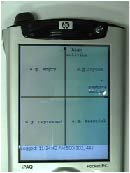Translations:Bisherige "continuous response" - Systeme/8/en: Unterschied zwischen den Versionen
Zur Navigation springen
Zur Suche springen
Alenz (Diskussion | Beiträge) (Die Seite wurde neu angelegt: „=== pARF === mini|Figure 3.9: Portable Audience Response Facility (Stevens, Vincs, and Schubert 2009, p. 101) The ''Portable Audience Respons…“) |
K (FuzzyBot verschob die Seite Translations:Interface-Historie/8/en nach Translations:Bisherige "continuous response" - Systeme/8/en, ohne dabei eine Weiterleitung anzulegen: Teil der übersetzbaren Seite „Interface-Historie“) |
(kein Unterschied)
| |
Aktuelle Version vom 9. November 2022, 14:47 Uhr
pARF
The Portable Audience Response Facility is designed to record audience responses during a performance. It works in one or two dimensions and is operated with a stylus and touch screen. One emotion is displayed per quadrant: angry, joyous, depressed and peaceful. It has been used in contemporary dance performances (Kopiez et al. 2011, pp.147-148). In this process, the results are time-stamped and can be synchronized. There is no possibility to play back stimuli via the device itself (Stevens, Vincs, and Schubert 2009).
